|
Fig. 1:
Onset of the supernova explosion of a star with 11 solar masses.
The images show a sequence of moments from the computer simulation
at 0.1, 0.18, 0.26, and 0.32 seconds (from top left to bottom right) after the stellar core has
collapsed to a neutron star.
(Visualization: Markus Rampp, Rechenzentrum Garching)
Movies are available at
 Rechenzentrum Garching Rechenzentrum Garching
|
 |
|
Fig. 2:
Onset of the supernova explosion of a star with 15 solar masses.
The images show a sequence of moments from the computer simulation
at 0.53, 0.61, 0.65, and 0.7 seconds (from top left to bottom right) after the stellar core has
collapsed to a neutron star.
(Visualization: Markus Rampp, Rechenzentrum Garching)
Movies are available at
 Rechenzentrum Garching Rechenzentrum Garching
|
 |
|  |
Nowadays astrophysicists have quite a clear picture of the processes
occurring in supernova explosions. However, for quite some years
scientists have been puzzling about exactly how the transport of
energy during a "Star Bang" happens. In a current research project
scientists from the Excellence Cluster Universe have gained new
insight into this question. Close supernovae are rare and hardly ever
observed "live". Therefore, Andreas Marek and Hans-Thomas Janka, two
researchers from the Max-Planck-Institute for Astrophysics, simulated
supernova processes in a computer model. For the first time
researchers succeeded in reproducing the interactions of neutrinos and
matter within stars of 11 to 15 times the mass of the sun - a project
which so far has used up more than ten million hours on several
supercomputers. The results will be published in one of the next
issues of Astrophysical Journal.
Stars are the chemical factories of the universe. In the core of
the star, hydrogen atoms fuse to helium under inconceivable pressure
and extremely high temperatures. Under suitable conditions the
reaction chain continues: In other words, from the fusion of helium
atoms, the heavier element carbon is produced, which in turn produces
oxygen. Stars of great mass, whose mass is at least eight times the
mass of our sun, continue the combustion processes in the core to
produce even heavier elements; stars with more than ten times the mass
of the sun even continue to produce iron. By contrast, the end of
heavy stars is disproportionately dramatic compared to their light
colleagues - after a lifespan of 100 million years at the most, they
end their existence with a tremendous supernova explosion.
During a supernova, it is presumed that massive stars at first
implode. In their advanced state, stars resemble an onion: In the
center there is a firm iron core with surrounding layers containing
the lighter elements up to hydrogen. With the production of iron, the
combustion processes responsible for the star's force equilibrium
stop: In order to merge iron nuclei it would be necessary to apply
energy from outside. Thus, the star becomes the victim of gravitation
and collapses. During this process, gravity compresses the core
more and more until the structure of the iron nuclei starts to
dissolve: The electrons fuse with the protons and as a result a
neutron star and a large amount of neutrinos emerge.
With the star's collapse, the matter of the star's outer layers
crashes onto the central neutron core. Because of the collision
onto the compact core, a shock front is formed and is reflected
towards the outer shells of the collapsing star. The neutron star's
intensive neutrino flow heats the matter behind the shock wave causing
a major expansion. Thus, the outer layers of the star are flung away
and the star bursts apart in a gigantic supernova explosion. The final
relic is a small neutron star with a diameter of approximately 20
kilometers or in very rare cases a Black Hole.
As plausible as this model sounds - it only applies to stars with no
more than ten times the mass of the sun. In the case of heavier stars
the explanation has a flaw: According to computer calculations the
neutrino-triggered explosion comes to a halt after approximately 100
kilometers. The reason for this is the dense material within the
core that decelerates the neutrinos. Moreover, in the early phase
of the supernova, debris from the outer layer falls into the center
and interferes with the dispersion of the shock wave. However,
observations of supernovae and supernova-relics show that the shock
front at a radius of 100 million kilometers finally reaches the
surface of the star to demolish the star's outer layer. Therefore, it
becomes clear that the explosion needs a second attempt. But what
happens and what generates the necessary energy?
With their simulations of stars with 11 to 15 times the mass of the
sun, scientists confirmed an assumption that had been discussed in the
literature for quite a while. The simulation suggested that even the
explosion of such massive stars could be powered by
neutrinos. However, in contrast to smaller stars, for massive stars
the crucial impetus is given by hydrodynamic instabilities. The star's
layers, heated by neutrinos, are swirled by convective currents,
similar to porridge boiling in a pot. During this process, the matter
develops mushroom-shaped bubbles, in which hot plasma arises. However,
the decisive trigger is a phenomenon called "Standing Accretion Shock
Instability" (SASI) that was not taken into consideration in earlier
models. This phenomenon causes the shock front to oscillate in growing
amplitudes and to "bulge" more and more. Thus, the shock wave will be
pushed to higher distances and the convection will
increase. Consequently, a third effect applies: in the SASI-model, the
matter is exposed to the high energy neutrinos much longer allowing
for a clearly higher transfer of energy.
"Our tests on two-dimensional computer models represent an important
step forward in understanding how stars of a high mass, with more than ten times the
mass of the sun, explode", explains Hans-Thomas Janka. "Maybe
there are still other phenomena which intensify the explosion caused
by neutrinos and hydrodynamic instabilities. A group of competitors
claim, for example, that SASI could cause great pulsation and
oscillation of the young neutron star, which then would generate sound
waves like a bell. The energy of these sound waves could also
contribute towards getting the explosion started. For this reason, in
the future we will be concentrating on combined effect mechanisms in
our simulation calculations."
Janka remarks that the current successful simulations are an
important piece in the puzzle. However, for the big picture there are
quite some pieces missing. "We will still need a couple of years
before we solve the problem of supernova explosions. Furthermore we
still have to transfer our 2D-simulations into a three-dimensional
computer model. The physics of neutrino-triggered energy transport are
so complex, that 3D-simulations push even high-performance computers
to their limits".
Barbara Wankerl (Public Outreach Coordinator, Exzellenzcluster `Universe')
Publication
A. Marek und H.-Thomas Janka,
"Delayed neutrino-driven supernova explosions aided by the standing
accretion-shock instability.",
The Astrophysical Journal, in the press
 http://xxx.uni-augsburg.de/abs/0708.3372 http://xxx.uni-augsburg.de/abs/0708.3372
Further Information
 Press Release Cluster of Excellence `Universe' Press Release Cluster of Excellence `Universe'
Acknowledgement:
This research project was supported by the Deutsche Forschungsgemeinschaft
through the
 Cluster of Excellence EXC 153 "Origin and Structure of the Universe"
as well as through the Transregional Collaborative Research Centers SFB/TR 27
"Neutrinos and Beyond" and SFB/TR 7 "Gravitational Wave Astronomy",
and through the Collaborative Research Center SFB-375 "Astro-Particle
Physics". The computations were performed on the IBM p690 of
the John von Neumann Institute for Computing (NIC) in Jülich,
on the national supercomputer NEC SX-8
at the High Performance Computing Center Stuttgart (HLRS) under
grant number SuperN/12758, on the IBM p690 of the Computer Center
Garching (RZG), on the sgi Altix 4700 of the Leibniz-Rechenzentrum (LRZ)
in Munich, and on the sgi Altix 3700 of the MPI for Astrophysics.
Support by AstroGrid-D, a project funded by
the German Federal Ministry of Education and Research (BMBF)
as part of the D-Grid initiative, is also acknowledged. Cluster of Excellence EXC 153 "Origin and Structure of the Universe"
as well as through the Transregional Collaborative Research Centers SFB/TR 27
"Neutrinos and Beyond" and SFB/TR 7 "Gravitational Wave Astronomy",
and through the Collaborative Research Center SFB-375 "Astro-Particle
Physics". The computations were performed on the IBM p690 of
the John von Neumann Institute for Computing (NIC) in Jülich,
on the national supercomputer NEC SX-8
at the High Performance Computing Center Stuttgart (HLRS) under
grant number SuperN/12758, on the IBM p690 of the Computer Center
Garching (RZG), on the sgi Altix 4700 of the Leibniz-Rechenzentrum (LRZ)
in Munich, and on the sgi Altix 3700 of the MPI for Astrophysics.
Support by AstroGrid-D, a project funded by
the German Federal Ministry of Education and Research (BMBF)
as part of the D-Grid initiative, is also acknowledged.
For further information please contact:
Dr. Hans-Thomas Janka
Max-Planck-Institut für Astrophysik, Garching
Tel.: +49 89 30000-2228
email: thj mpa-garching.mpg.de mpa-garching.mpg.de
Barbara Wankerl
Excellence Cluster Universe
Technische Universität München
Tel.: +49 89 35831-7105
email: barbara.wankerl universe-cluster.de universe-cluster.de
|
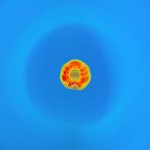
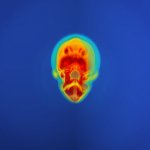
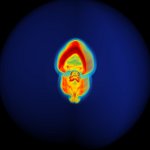
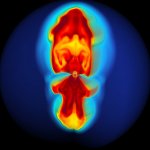
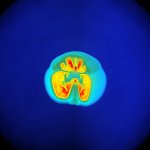
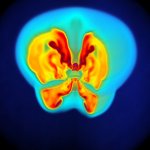
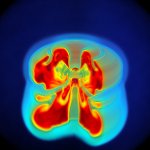
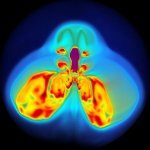
 mpa-garching.mpg.de
mpa-garching.mpg.de